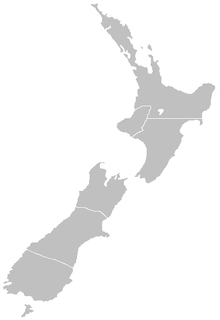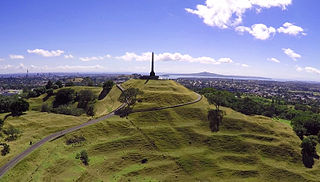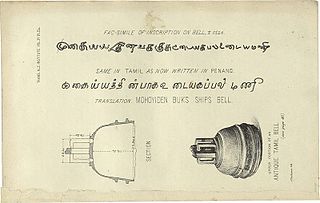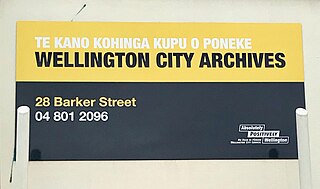 W
WThe history of New Zealand (Aotearoa) dates back approximately 700 years to when it was discovered and settled by Polynesians, who developed a distinct Māori culture. Like other Pacific cultures, Māori society was centred on kinship links and connection with the land but, unlike them, it was adapted to a cool, temperate environment rather than a warm, tropical one.
 W
WThis is a bibliography of New Zealand history.
 W
WThe storm of 1897 was a severe storm that struck the lower to central North Island of New Zealand on 16 April 1897. It caused the ship Zuleika to run aground near Cape Palliser, with the loss of 12 lives, and severe flooding. At Clive the flooding caused the loss of a further 12 lives and one person was drowned near Kapiti. There were six further unconfirmed reports of drowning, bringing the total loss of life directly related to the storm event to between 25 and 31. Based on descriptions of the storm, particularly that of Captain Marten of the Waiapu, it may have been an extratropical cyclone.
 W
WThe 1951 New Zealand waterfront dispute was the largest and most widespread industrial dispute in New Zealand history. During the time, up to twenty thousand workers went on strike in support of waterfront workers protesting against financial hardships and poor working conditions. Thousands more refused to handle "scab" goods. The dispute was sometimes referred to as the waterfront lockout or waterfront strike. It lasted 151 days, from 13 February to 15 July 1951. During the strike, the Watersiders' Union was deregistered and its funds and records were seized, and 26 local watersiders' unions were set up in its place.
Fox News Channel journalists Olaf Wiig, a New Zealand photojournalist, and Steve Centanni, an American reporter, were kidnapped in the Gaza Strip by the Holy Jihad Brigades, a previously unknown group of Palestinian militants, from their TV van near the Palestinian security services' headquarters on August 14, 2006.
 W
WThis is a timeline of the history of New Zealand's involvement with Antarctica.
 W
WWellington has been the capital of New Zealand since 1865. New Zealand's first capital city was Old Russell (Okiato) in 1840–41. Auckland was the second capital from 1841 until 1865, when Parliament was permanently moved to Wellington after an argument that persisted for a decade. As the members of parliament could not agree on the location of a more central capital, Wellington was decided on by three Australian commissioners.
 W
WThe Cartography of New Zealand is the history of surveying and creation of maps of New Zealand. Surveying in New Zealand began with the arrival of Abel Tasman in the mid 17th century. Cartography and surveying have developed in incremental steps since that time till the integration of New Zealand into a global system based on GPS and the New Zealand Geodetic Datum 2000.
 W
WThe Colony of New Zealand was a British colony that existed in New Zealand from 1841 to 1907, created as a Crown colony. The power of the British Government was vested in the governor of New Zealand, but the colony was granted self-government in 1852. The New Zealand Constitution Act 1852 was passed and the first parliament was elected in 1853; the first responsible government was formed in 1856. The Colony of New Zealand had three capitals: Old Russell (1841), Auckland (1841–1865), and Wellington. In 1907, the colony became the Dominion of New Zealand with a more explicit recognition of self-government within the British Empire.
 W
WThe bicycle originally reached New Zealand in the 1860s in the form of the velocipede, also known as the 'boneshaker'. These bikes, as elsewhere, soon evolved into the elegant 'high wheelers', known today as penny-farthings. Popular among wealthy young men, these offered adventure and speed, but were also dangerous due to the lack of modern features like efficient brakes. Additionally the fact that they were useless on the rough and hilly roads of most of the country, ensured that they were seldom used for anything other than sport and recreation.
 W
WThe Dominion of New Zealand was the historical successor to the Colony of New Zealand. It was a constitutional monarchy with a high level of self-government within the British Empire.
 W
WThe history of the Māori began with the arrival of Polynesian settlers in New Zealand, in a series of ocean migrations in canoes starting from the late 13th or early 14th centuries. Over several centuries of isolation, the Polynesian settlers formed a distinct culture that became known as the Māori.
 W
WThe Māori King Movement, called the Kīngitanga in Māori, is a movement that arose among some of the Māori tribes of New Zealand in the central North Island in the 1850s, to establish a role similar in status to that of the monarch of the British colonists, as a way of halting the alienation of Māori land. The Māori monarch operates in a non-constitutional capacity with no legal or judicial power within the New Zealand government. Reigning monarchs retain the position of paramount chief of several tribes (iwi) and wield some power over these, especially within Tainui.
 W
WThe Mission House at Kerikeri in New Zealand was completed in 1822 as part of the Kerikeri Mission Station by the Church Missionary Society, and is New Zealand’s oldest surviving building. It is sometimes known as Kemp House.
 W
WMokomokai, or Toi moko, are the preserved heads of Māori, the indigenous people of New Zealand, where the faces have been decorated by tā moko tattooing. They became valuable trade items during the Musket Wars of the early 19th century.
 W
WThe New Zealand and South Seas Exhibition was an international exhibition held in Dunedin, New Zealand from 26 November 1889 to 19 April 1890.
 W
WNew Zealand's archaeology started in the early 1800s and was largely conducted by amateurs with little regard for meticulous study. However, starting slowly in the 1870s detailed research answered questions about human culture, that have international relevance and wide public interest. Archaeology has, along with oral traditions, defined New Zealand's prehistory and has been a valuable aid in solving some later historical problems. Academically New Zealand's human prehistory is broadly divided into Archaic after c. 1300 AD and Classic (~neolithic) after c. 1500 AD periods, based on Māori culture. Eurasian labels do not perfectly fit as some level of horticulture was always present in northern New Zealand, even existing at the same time as megafauna. More simply it can also be divided into time periods of pre and post European contact. Large poorly documented sections of New Zealand's more recent history have also been supplemented by archaeological research, such as at old battle sites or early urban centres.
 W
WThe New Zealand Centennial Exhibition took place over six months from Wednesday 8 November 1939 until 4 May 1940. It celebrated one hundred years since the signing of the Treaty of Waitangi in 1840 and the subsequent mass European settlement of New Zealand. 2,641,043 visitors attended the exhibition.
 W
WThe New Zealand Company, chartered in the United Kingdom, was a company that existed in the first half of the 1800s on a business model focused on the systematic colonisation of New Zealand. The company was formed to carry out the principles devised by Edward Gibbon Wakefield, who envisaged the creation of a new-model English society in the southern hemisphere. Under Wakefield's model, the colony would attract capitalists who would then have a ready supply of labour—migrant labourers who could not initially afford to be property owners, but who would have the expectation of one-day buying land with their savings.
 W
WThe New Zealand Company was a 19th-century English company that played a key role in the colonisation of New Zealand. The company was formed to carry out the principles of systematic colonisation devised by Edward Gibbon Wakefield, who envisaged the creation of a new-model English society in the southern hemisphere. Under Wakefield's model, the colony would attract capitalists who would then have a ready supply of labour—migrant labourers who could not initially afford to be property owners, but who would have the expectation of one day buying land with their savings.
 W
WThe New Zealand Industrial Exhibition was an industrial exhibition held in a large Industrial Exhibition Building in Wellington, between Lambton Quay and Stout Street in 1885. Organised by Julius Vogel it was intended to display New Zealand's industries to both encourage foreign investment and to boost New Zealand's self-confidence.
 W
WThe New Zealand land confiscations took place during the 1860s to punish the Kingitanga movement for attempting to set up an alternative, Māori, form of government that forbade the selling of land to European settlers. The confiscation law targeted Kingitanga Māori against whom the government had waged war to restore the rule of British law. More than 1,200,000 hectares or 4.4 percent of land were confiscated, mainly in Waikato, Taranaki and the Bay of Plenty, but also in South Auckland, Hauraki, Te Urewera, Hawke's Bay and the East Coast.
 W
WThe Oranjehof Dutch Connection Centre is one of the two museums that are part of the multi-cultural, multi-purpose visitor and community hub Te Awahou Nieuwe Stroom in Foxton, New Zealand, just over an hour's drive north of Wellington.
 W
WPostal services in New Zealand have existed since at least 1831, when the Postmaster-General of New South Wales deputed a Bay of Islands merchant to receive and return mail. Governor William Hobson issued an ordinance covering postal matters, although the British government retained control until 1848.
 W
WSince the early 1900s the theory that Polynesians (Māori) were the first ethnic group to settle in New Zealand has been dominant among archaeologists and anthropologists. Before that time and until the 1920s, however, a small group of prominent anthropologists proposed that the Moriori people of the Chatham Islands represented a pre-Māori group of people from Melanesia, who once lived across all of New Zealand. While this idea lost favour among academics, it was widely published and incorporated into school textbooks which has extended its life in the popular imagination.
 W
WThe Tamil Bell is a broken bronze bell discovered in approximately 1836 by missionary William Colenso. It was being used as a pot to boil potatoes by Māori women near Whangarei in the Northland Region of New Zealand.
 W
WThe 1886 eruption of Mount Tarawera occurred in the early hours of 10 June 1886 in the North Island near Rotorua then extended to Waimangu, New Zealand. It is the deadliest eruption in New Zealand since the arrival of Europeans. Around 120 people were killed, and many settlements were destroyed or buried.
 W
WTe Heuheu Tukino IV (1821–1888) was paramount chief of the Ngāti Tuwharetoa, a Māori tribe of the central North Island of New Zealand. His birth name was Pataatai but he assumed the name Horonuku - meaning landslide - after the death of his parents in a landslide in 1846. He was placed under house arrest by the Crown and forced to gift the mountains of Ruapehu, Tongariro and Ngauruhoe in 1887 for the creation of Tongariro National Park.
 W
WTe Waimate Mission was the fourth mission station established in New Zealand and the first settlement inland from the Bay of Islands. The members of the Church Missionary Society (CMS) appointed to establish Te (the) Waimate Mission at Waimate North were the Rev. William Yate and lay members Richard Davis, George Clarke and James Hamlin.
 W
WThe temperance movement in New Zealand originated as a social movement in the late-19th century. In general, the temperance movement aims at curbing the consumption of alcohol. Although it met with local success, it narrowly failed to impose national prohibition on a number of occasions in the early-20th century. Temperance organisations remain active in New Zealand today.
 W
WThe Vogel Era: New Zealand adopted in the 1870s an immigration and public works scheme inaugurated by Colonial Treasurer then Premier Julius Vogel to develop the country and to relieve the slump of the late 1860s; to be financed by borrowing overseas. His "Great Public Works Policy" resulted in a large increase in migrants and provision of many new railways, roads and telegraph lines. The railway system developed from a few lines in three gauges to the start of a national network including the main line from Christchurch to Dunedin, though the narrow "Cape gauge" required later upgrading to increase the restricted height and weight limits.
 W
WThe Wellington City Archives preserves records of the Wellington City Council and other organisations relating to the history of Wellington, New Zealand. Established in 1994, the Council archives were housed in a single purpose-built facility in 1995, opened to the public in 1996, and made available online since 2007.